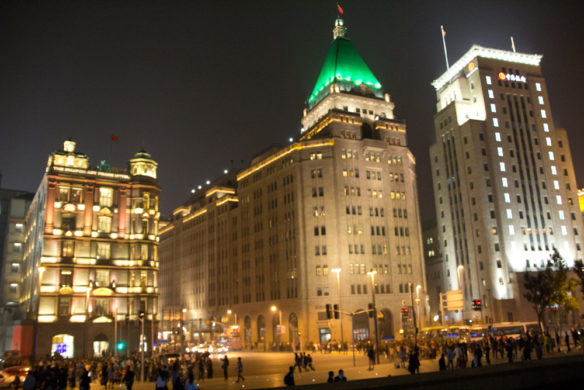
Shanghai is an international mecca of Art Deco design. This night scene features two of the city’s architectural gems—the Fairmont Peace Hotel (center) and the Bank of China (right).
I’m back in the USA for the summer. This past year, I spent another season in Shanghai—that exotic, endlessly fascinating, and ever-changing city. I’ve compiled the best of the stories and pictures I gathered about social life and travels in China in diary form, and I’ll be posting them from time to time. Here’s another:
HISTORIC SHANGHAI
Though Shanghai is becoming known for its flashy Lamborghinis and mirrored skyscrapers, it seduces many newcomers with its historic charms—the stately Neoclassical buildings on the Bund, the tree-lined streets of the former French Concession, the beautiful chaos of its teeming lane neighborhoods.
Shanghai’s living past beguiles some of these newcomers to remain for decades and to become passionate advocates for its study and preservation.
Among the foremost examples are Tess Johnston, Patrick Cranley, and Tina Kanagaratnam. Tess, a full-time author retired from the U.S. Foreign Service, has lived here almost continuously since the 1980s, while Patrick and Tina, who run the marketing and communications firm Asia Media, arrived in 1997.
In 1998, the trio established the Shanghai Historic House Association, now called Historic Shanghai. A loose association of mostly expatriates, it is dedicated to raising awareness of the social and architectural heritage of the city through research, publications, programs, and tours.
I refer often to guidebooks edited by Tess (Walking Tours of Shanghai and Still More Shanghai Walks) and to Tina and Patrick’s contributions to Insight Guide Shanghai.

Historic Shanghai founders Tess Johnson, Patrick Cranley, and Tina Kanagaratnam. (Photo courtesy Shanghai-Today.com)
Among the Art Déco gems for which Shanghai is famous:

The Grosvenor House apartments (l931), built by Sir Victor Sassoon, an Iraqi Jew who inherited business interests in shipping, banking, and the opium trade from his father and grandfather. Sassoon built some of the most impressive structures in Shanghai during its economic boom of the l920s and ’30s.
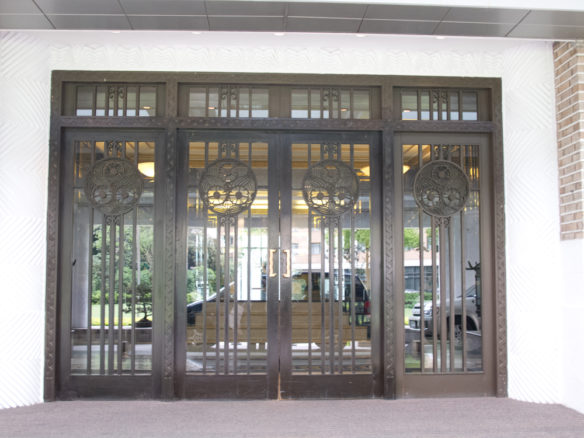
The entrance to the Grosvenor. Contrary to popular belief, its official “Heritage Architecture” status does not legally protect it from destruction or redevelopment.
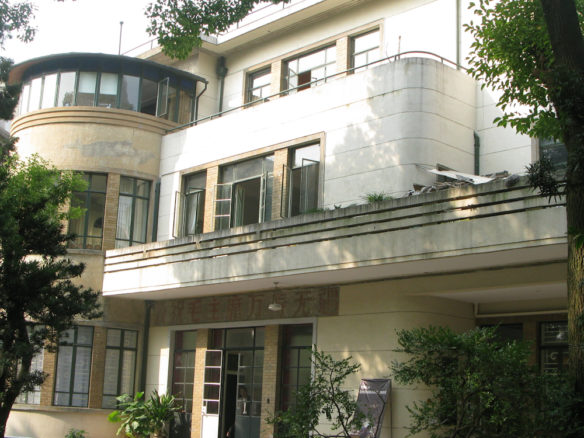
This sleek Art Deco garden villa (1930s) now houses the Shanghai branch of the James Cohan Gallery.
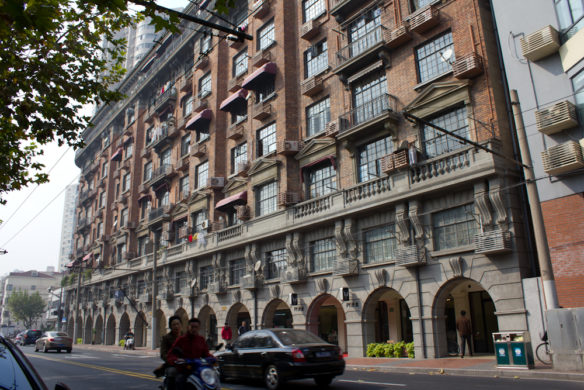
The Normandie Apartments (1924), designed by Hungarian architect Laszlo Hudec in the shape of a ship, resemble New York’s Flatiron building.
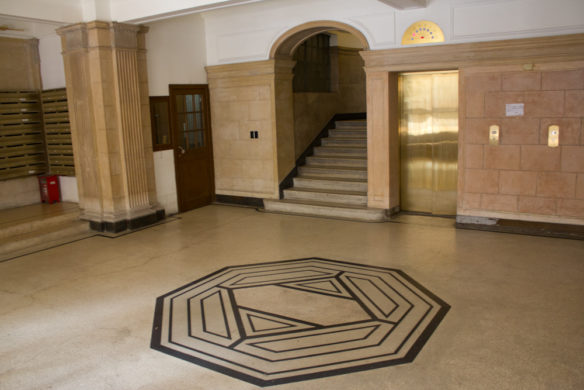
The Normandie’s stunningly renovated interiors feature the smooth, clean lines typical of Art Deco.
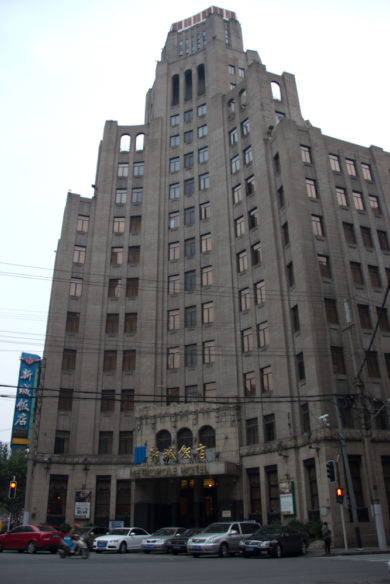
The Metropole Hotel (Palmer and Turner, 1930) has a characteristically streamlined exterior.
ART DECO CONFERENCE 2015
Historic Shanghai recently won its bid to host the World Conference on Art Deco in 2015 thanks to Patrick Cranley’s efforts. The Miami Design Preservation League began the organization in 1991 and the conference has taken place in a beautiful city every two years since.
In the ’20s and ’30s, Shanghai, then a prosperous international mecca, enjoyed a building boom. Artists and designers rejected traditional colonial neoclassical style and embraced Art Deco, incorporating Chinese elements to add a geometric twist.
Unfortunately, many architectural treasures have been razed, others are in ruin, and ongoing construction continues to threaten the city’s character, though enough gems remain for the city to be considered a showcase for unique Art Deco architecture. More than 200 experts and thousands of enthusiasts are expected for the 2015 conference.
MORE ART DECO IN SHANGHAI
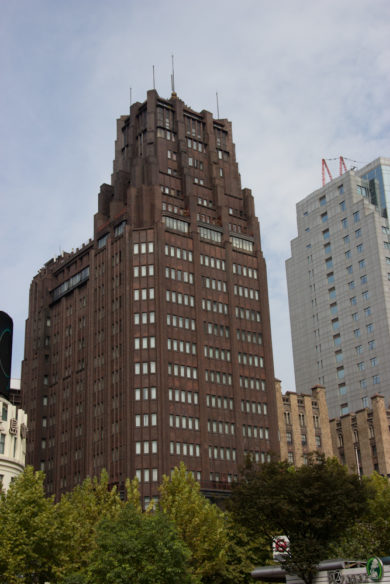
Laszlo Hudec’s 1934 masterpiece, the 22-story Shanghai Park Hotel (called “The International Hotel” in Chinese) was until the 1980s the city’s tallest building.
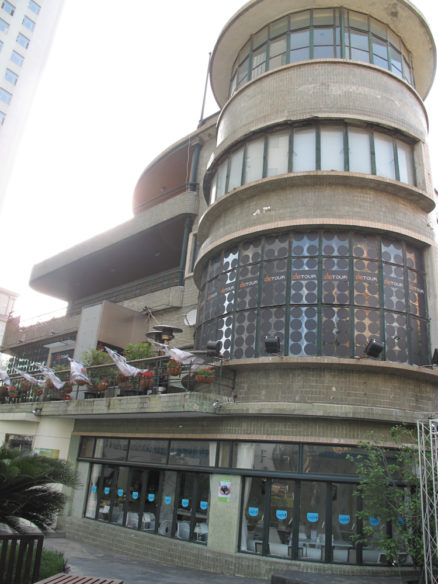
The D. V. Woo House, also designed by Laszlo Hudec, illustrates the modern style of 1930s Shanghai villas and apartments.

Known simply as “1933” (the year in which it was built as a slaughterhouse), this architectural marvel is now a cultural center.

The six-floor Rock Bund Museum (1933), one of the first museums in China, formerly belonged to the Royal Asiatic Society. Architectural details were preserved when it was renovated a few years ago.
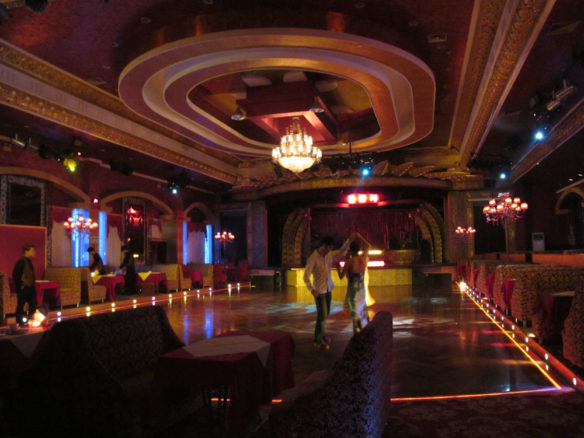
The Paramount Ballroom (Yang Xiliu, 1934), once one of the city’s most celebrated dance halls with famous dancing hostesses, was extensively (and inaccurately) renovated about ten years ago.

The Fairmont Peace Hotel (originally the Cathay Hotel), built by tycoon Sir Victor Sassoon in 1929, is located on the famous Bund Promenade.

The Bank of China Building (Palmer and Turner, 1937) is a prime example of how architects integrated Chinese motifs into Art Deco design.
HISTORIC SHANGHAI’S ART DECO TOUR IN THE FORMER FRENCH CONCESSION
Patrick Cranley leads a monthly tour of some of the Art Deco buildings in the former French Concession, the premiere residential and retail area that has retained much of its character.
Even though I’ve been numerous times, I always go on Patrick’s tour when I’m in town. The walk route changes and I see something new each time.
Historic Shanghai has researched and documented the city’s history, architecture, and urban development, so Patrick’s tours are informative and supply historical and social information about China, Shanghai, and the French Concession.
Since Patrick knows this town and its people well, he opens doors to places you’d never go on your own. On the tour, he explained how the International Settlement and the French Concession came into being.
Shanghai was one of the original five treaty ports established in 1842 by the Treaty of Nanking after the First Opium War (1839–42). After the treaty, the British, Americans, French, and others established and controlled separate areas of settlement. Later, the British and Americans merged to form the International Settlement, while the French remained independent.
In the 1930s, Shanghai’s population of more than 3 million made it the world’s sixth-largest city. Of the 600,000 residents of the French Concession district, a small minority was foreign: just 1,400 French, 2,000 Americans, and 2,500 British, with a sprinkling of other nationalities.
By the 1930s, the largest expatriate population in the French Concession was the group of about 10,000 “White Russians” (distinguished from the “Reds”), about a quarter of whom were Jewish.
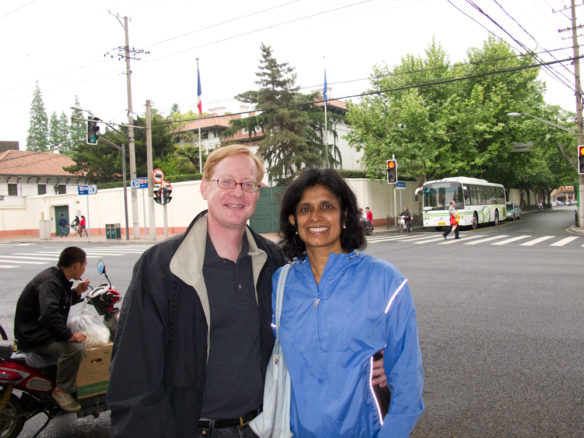
Patrick Cranley leads a tour organized by Historic Shanghai, the group he co-founded with his wife Tina Kanagaratnam and Tess Johnson.
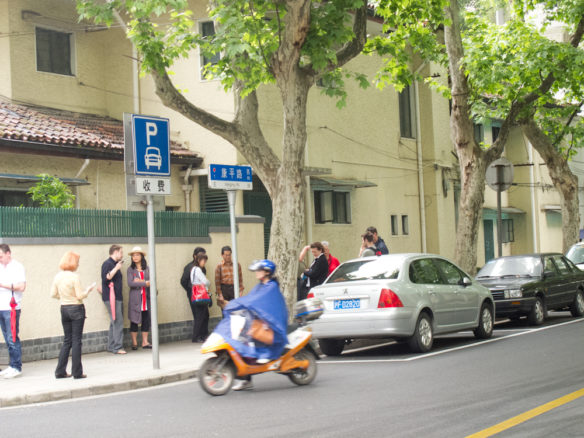
The two-hour tour meets at the corner of Gao An and Kang Ping Roads on the third Sunday of (almost) every month at 10 a.m. There are usually 10-15 people from around the world. (If you come, wear your walking shoes!)
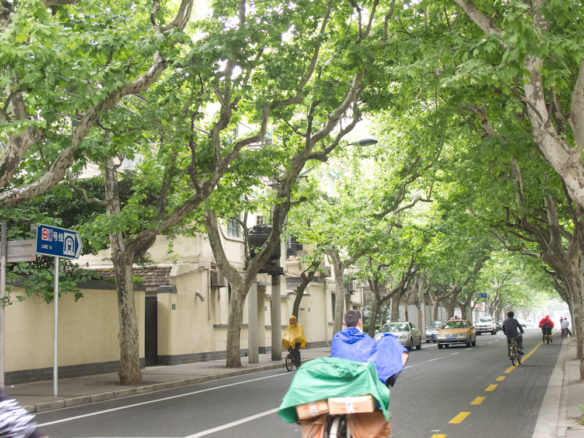
One of Shanghai’s charms are the “plane trees” (les platanes in French) that line the streets and avenues of the former French Concession.

Our first stop was the Amyron Apartments (c.1941), designed by French architect Alexandre Leonard, who lived in the penthouse with his beautiful Russian songstress wife, Anna. Patrick showed us their initials in the terrazzo floor in the original Art Deco lobby.

Patrick pointed out the demarcations on the map for the various foreign concessions (1843-1943), which included the English and American Settlements (later combined into the International Settlement) and the French Concession.
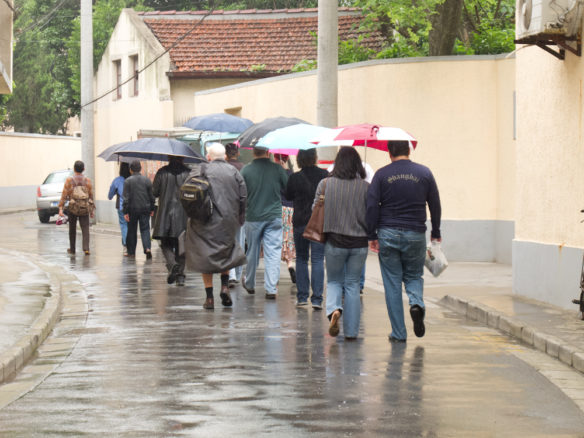
Wearing walking shoes and carrying umbrellas, we followed Patrick at a quick pace. He took us into one of Shanghai’s characteristic “lane neighborhoods.” The lanes are like secret passages off the main street where you can see how locals really live.
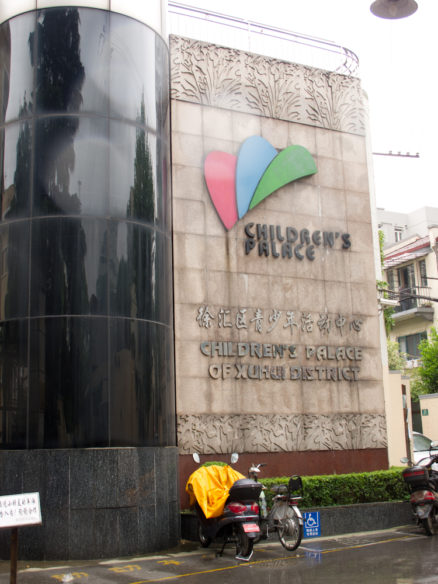
Our tour entered the gates of the Xuhui District Children’s Palace to visit the Art Deco mansion (1939) of tycoon Rong Desheng, now used as an after-school activity center where students learn music, calligraphy, and dancing.

Patrick pointed out details on houses of interest. Much of the former French Concession is protected and retains characteristics of the past.
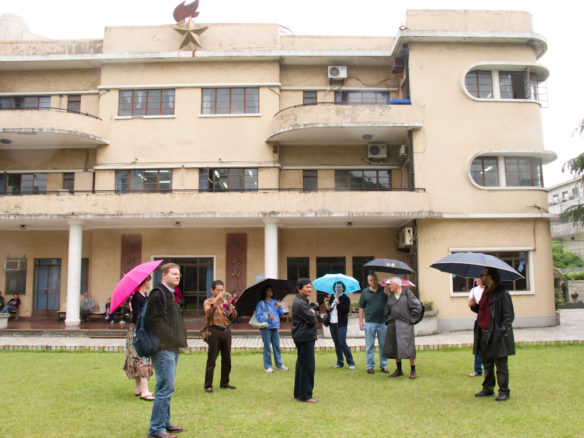
The Rong Desheng Villa (1939), designed by architects Leonard, Veysseyre & Kruze.
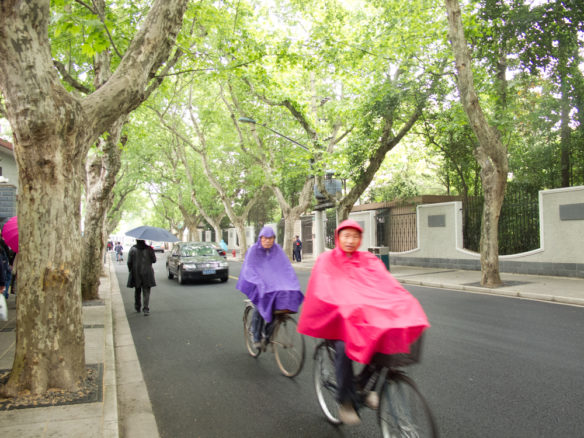
On Sunday mornings, many of these residential roads are quiet and traversed by bicycles only, but each year you see more and more cars in the alleys and on the streets, changing the tranquil atmosphere.
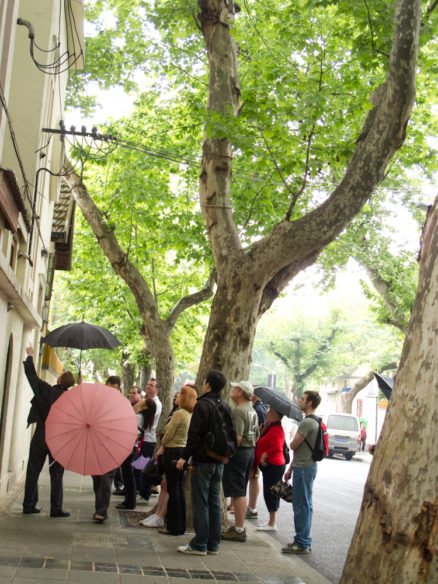
Patrick brought our attention to Art Deco architectural details.

Off the side streets, you often find little gems such as this multi-family house with its own shared garden.
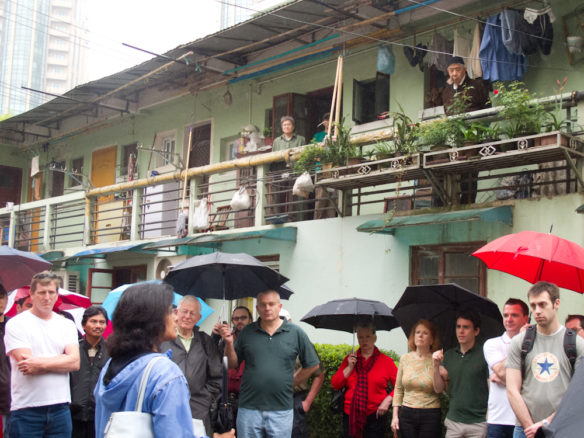
Down another lane, we stop to see a multi-family dwelling that was once the home of a Chinese builder surnamed Pan, whose company constructed several landmark buildings in Shanghai.

After the establishment of the People’s Republic of China in 1949, many of the homes of the well-to-do were abandoned by their owners and became state property. Others were seized during the “Cultural Revolution” (1966-76).

This tree sculpture and fountain in Xujiahui Park was presented to the city of Shanghai by the French city of Bordeaux. Shanghai has many “sister cities” around the globe, including San Francisco.
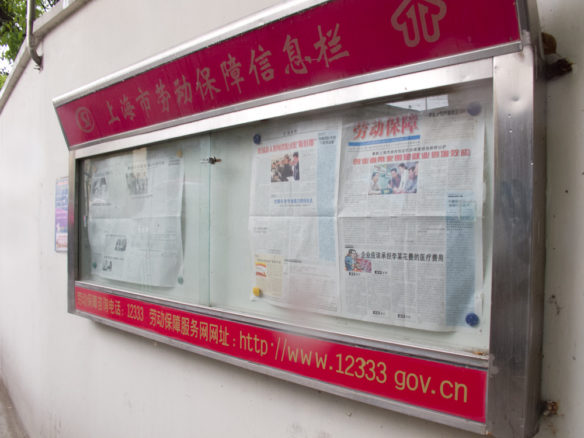
Newspapers and public announcements are posted on community bulletin boards around the city. You often see groups of residents standing and reading the news together.
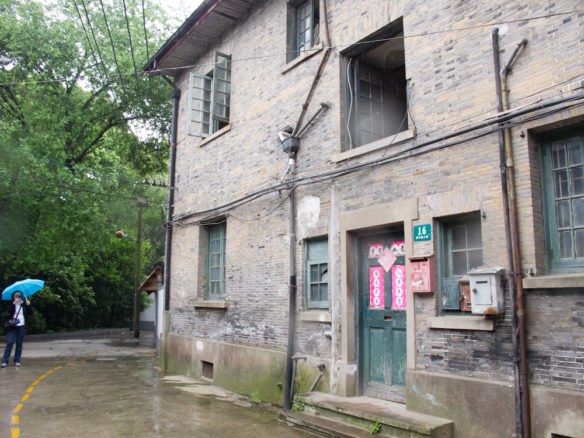
We walked down lane after lane, passing once grand mansions in various conditions, some renovated and others that have fallen into ruin.
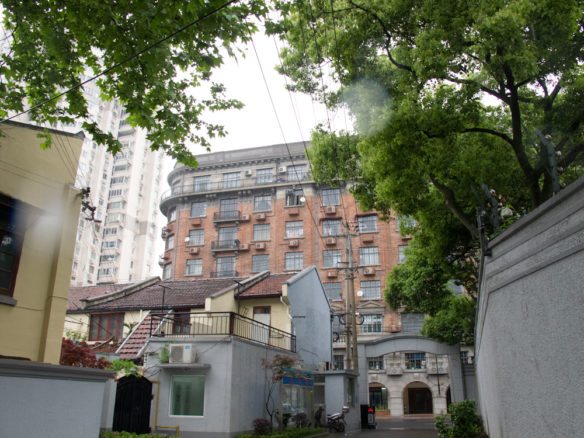
At the end of the lane is another view of the Art Deco Normandie Apartments.
FERGUSON LANE
Off Wukang Road, we turned into a trendy little alley called 376 Ferguson Lane. It has an art gallery, several restaurants (including the French bistro Franck, a favorite of mine), a flower shop, boutiques such as Mary Ching shoes, a wine bar, and offices.
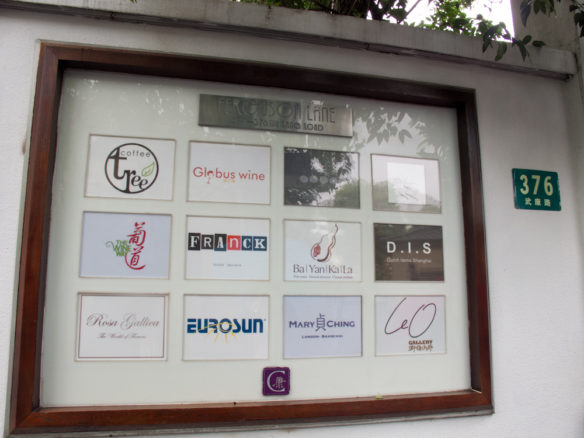
The signage at 376 Ferguson Lane lists the many businesses here.

A tastefully restored area in the French Concession, 376 Ferguson is one of my favorite spots—a quiet refuge and a charming stopping-off point.
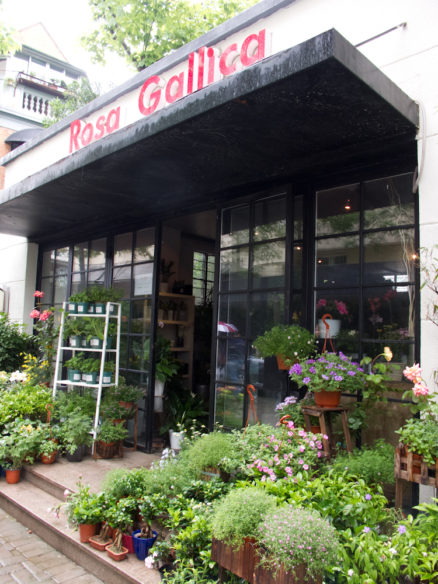

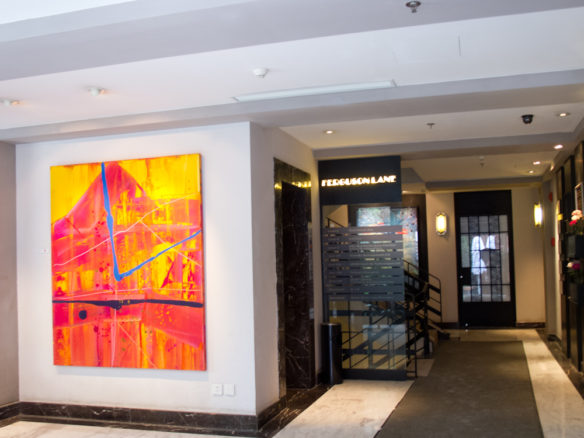

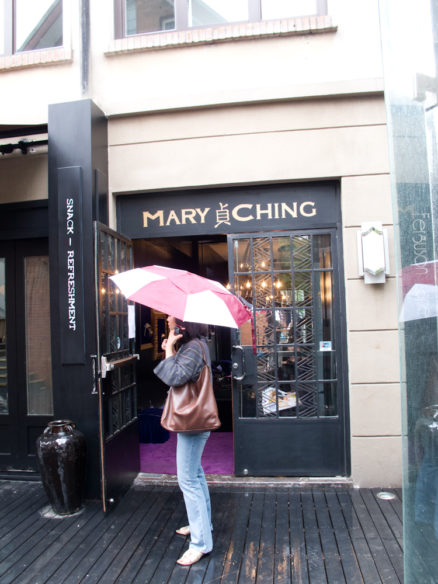
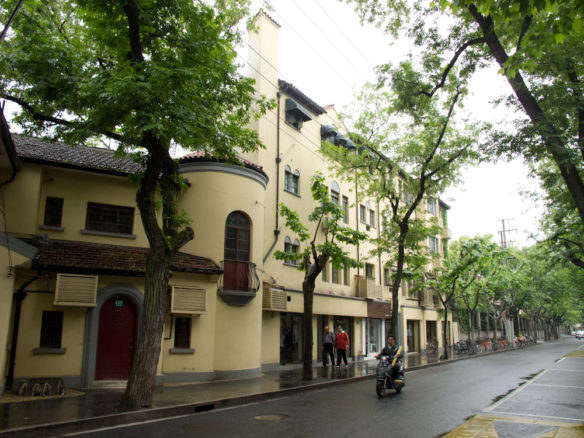
Exiting Ferguson Lane, we continued past lovely Concession-era homes in a variety of styles.

Some of the villas are hidden away, so there are always surprises as you walk these streets.

Behind these closed gates, there are many villas and mansions. Regrettably, one can’t take a peek, as many of the best are used as Communist party, military, and government offices.

Down the block, local shops are interspersed with upscale boutiques.

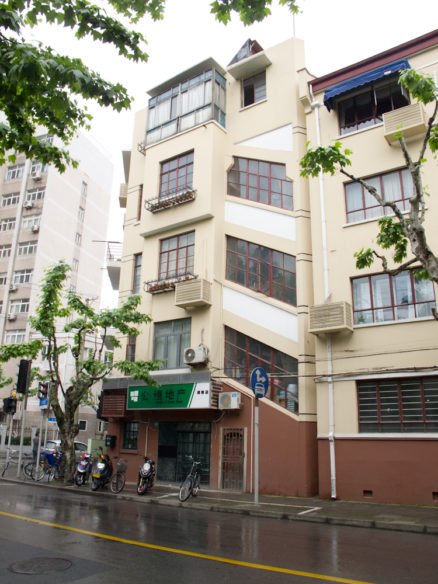

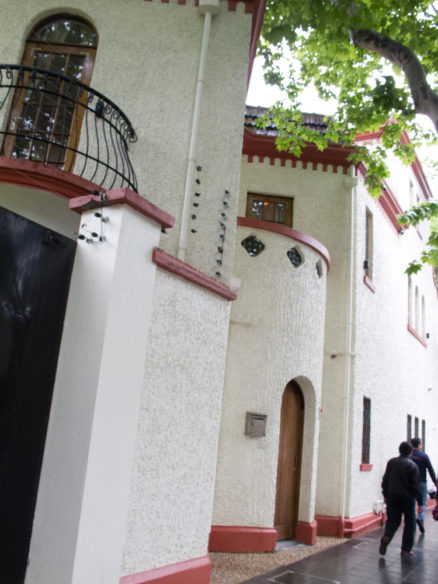
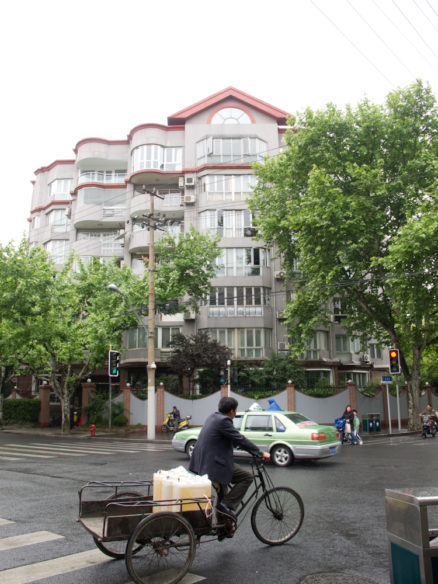

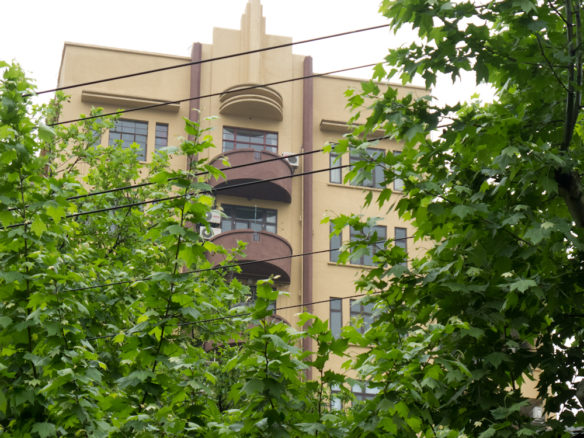
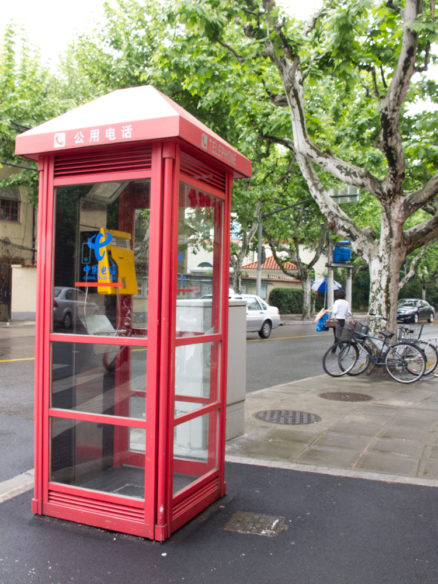
LOCAL FLAVOR
At the corner of Wulumuqi Road, we passed more shops and restaurants frequented by local residents: small cafes, fruit stands, teashops, and the like.

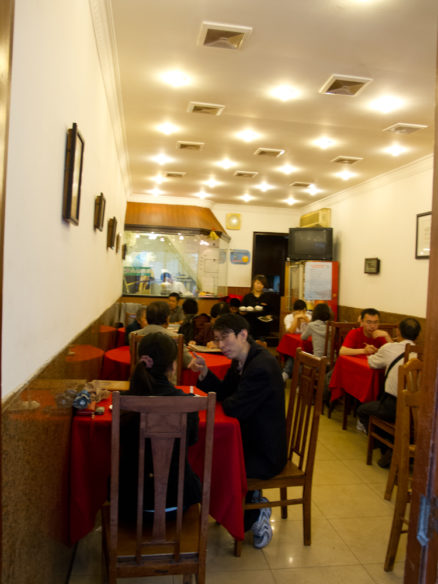
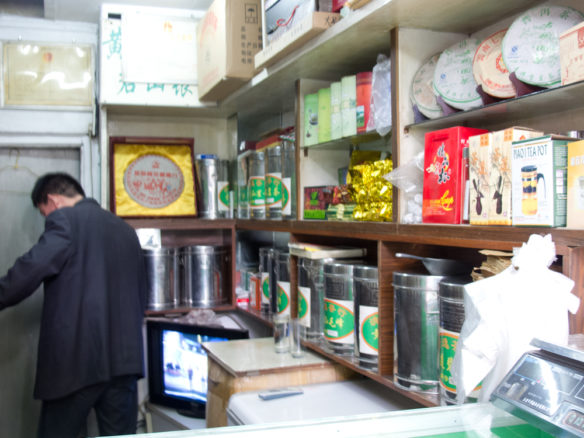
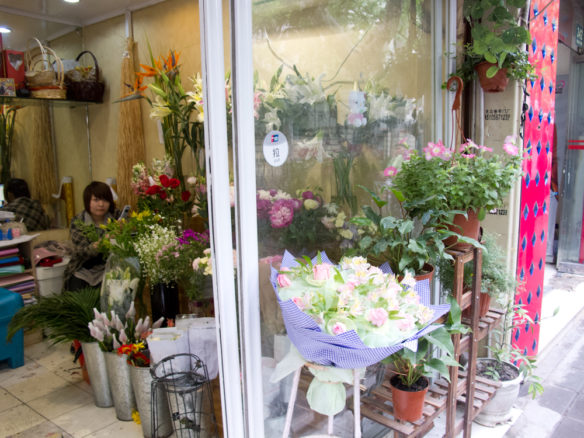

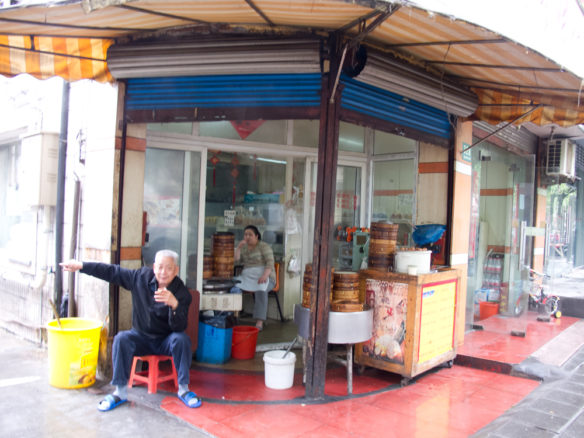
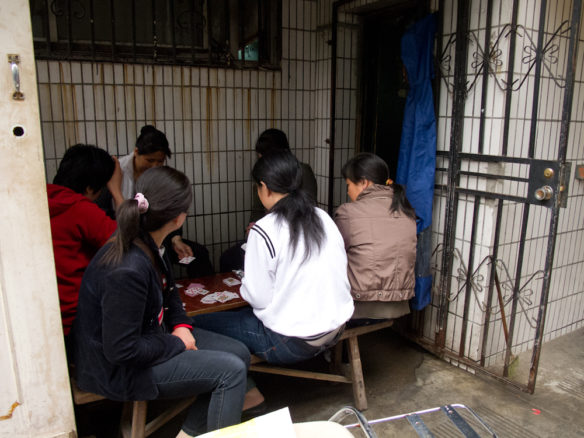
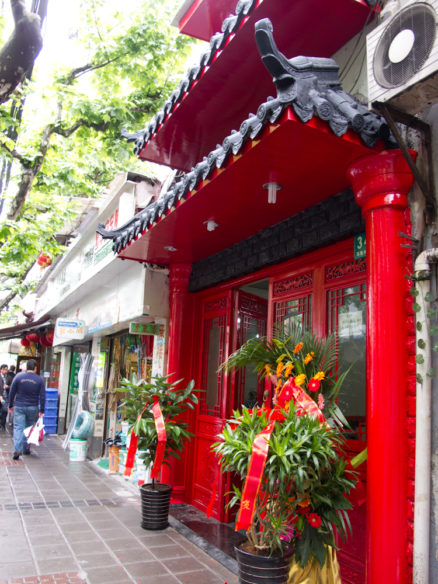
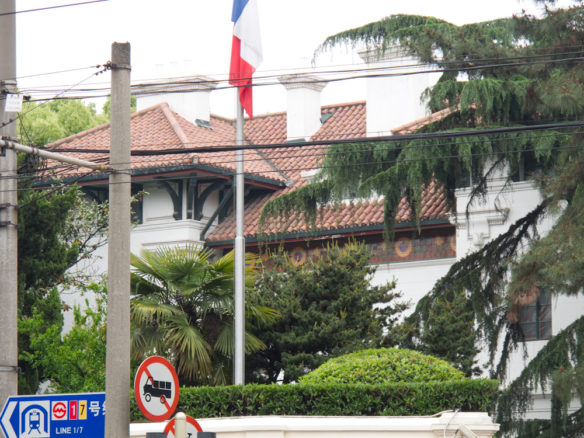
Our tour concluded at a stunning 1920s villa used as the French consul general’s residence. The house has changed hands many times over the years. One of its most notorious residents in the 1930s was Frank Raven, an accountant who famously defrauded many of the Christian missionary organizations that were his clients.
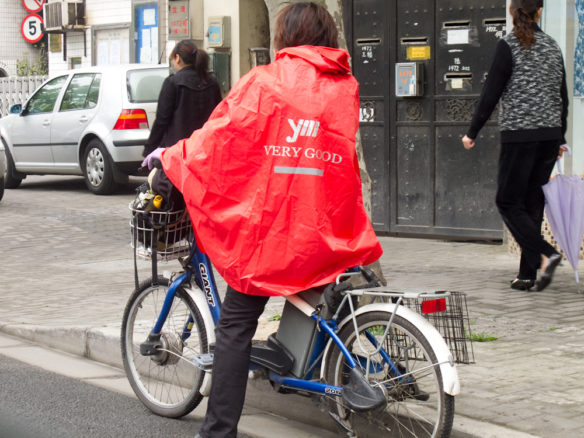
This bicycle rider says it all. The tour was very good!
ANOTHER SUNDAY, ANOTHER TOUR WITH HISTORIC SHANGHAI
When I joined Patrick for another Sunday morning tour along a different route, I learned even more about the former French Concessions.
Amusingly, the French wanted to “do their own thing;” they set up an electrical grid and a streetcar track system unlike the ones that served the rest of Shanghai and the International Concession. As they say, “Plus ça change, plus c’est la même chose.”
Patrick says young Shanghainese often comment that though they’ve lived here all their lives, the first time they learned about the history of the city was from him.
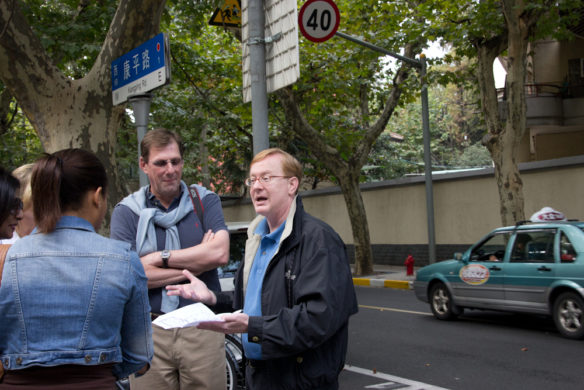
I visited another part of the French Concession on a subsequent tour with Historic Shanghai co-founder Patrick Cranley.
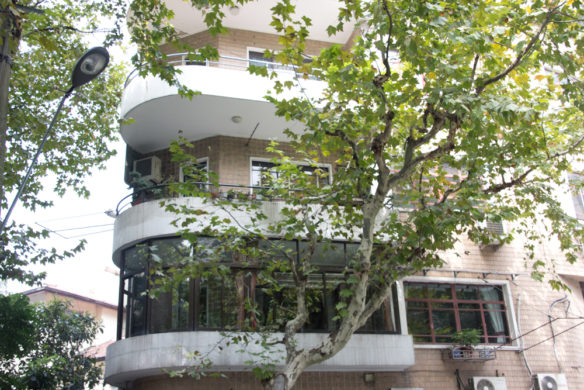



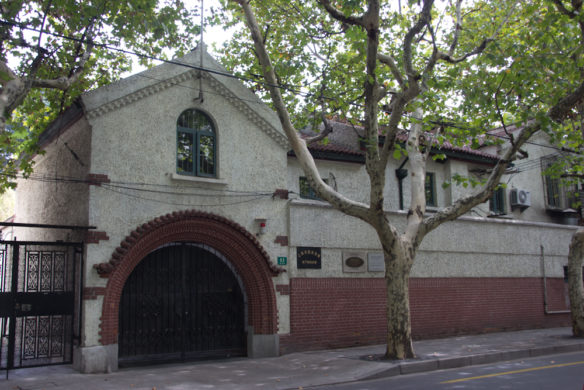
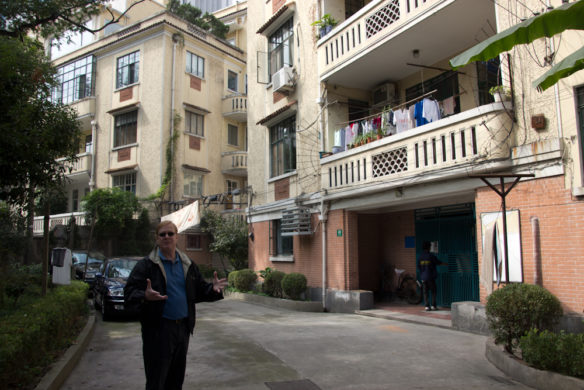
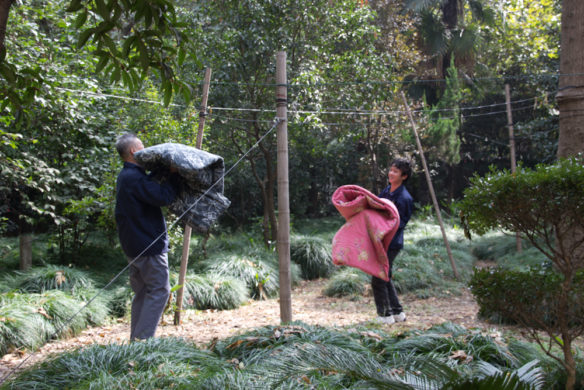


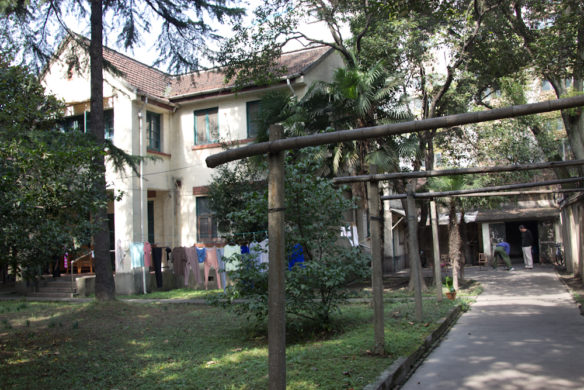

INTERNATIONAL COMMUNITY CHURCH
We stopped at Hengshan Lu, known as Avenue Petain in the time of the French Concession. With its tree-lined, orange-tiled sidewalks, wrought-iron railings, ivy-covered mansions, and bountiful cafes, this is one of Shanghai’s trendier streets.
Patrick recalled for us how all religions coexisted in Shanghai’s French Concession: Protestantism, Daoism, Islam, Catholicism, Buddhism, and Judaism.
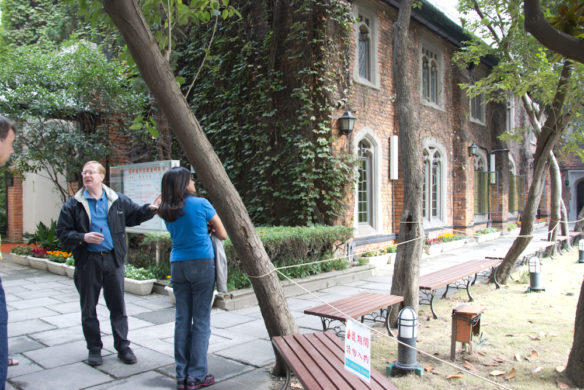
A gate opens the way to the ivy-covered International Community Church, established in 1925. Shanghai’s largest Protestant church, it’s attended by many members of the foreign community.
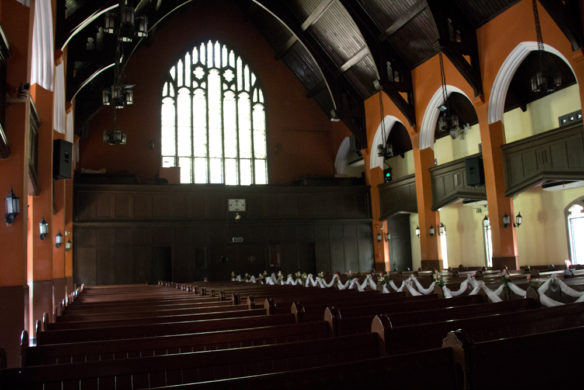
The multi-denominational Gothic-style church has a red brick exterior and slate tile roof. The interior is divided into a chapel and two three-story wings.
A SICHUAN LUNCH
When the tour ended at 1 p.m., two Swedish couples and I had lunch at the popular Sichuan restaurant Pin Chuan. When eating Chinese food, it’s best to dine with a large group so you can share more items.
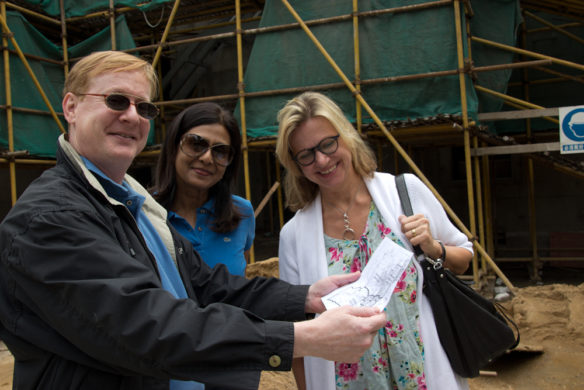
Heading to lunch, we stopped to see one of the historic buildings being renovated into another exclusive private club.

Historical Shanghai leader Patrick Cranley with me, Jeanne Lawrence, at the entrance to Pin Chuan, a Sichuan restaurant popular with locals and expats.

We studied the large menu and ordered authentic hot and spicy dishes, though we made sure that not all of them were full of peppers.
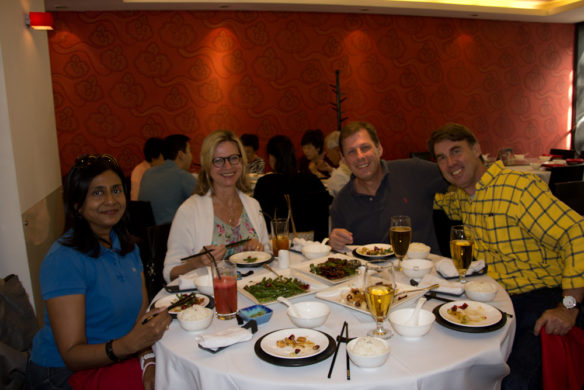
Vimala and Staffan Soderqvist, with friends Helena and Michael Thurow, enjoyed the fiery Sichuan-style cooking.
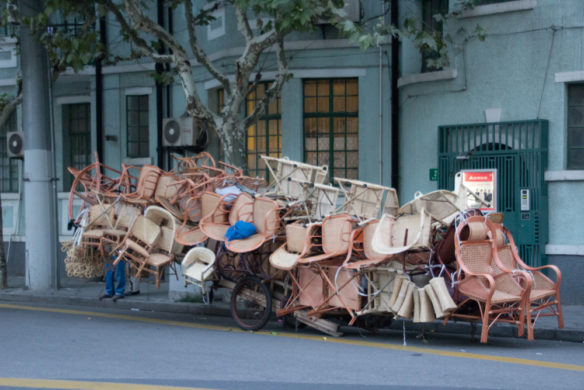
Upon leaving lunch, I snapped this amusing shot of a vendor towing his chairs down the street.
TESS JOHNSTON’S BOOK LECTURE
On another day at the Shanghai Community Center, I attended a lecture by Tess Johnston, historian, author, and co-founder of Historic Shanghai. She first came to Shanghai in 1981 to work at the American Consulate General, and retired here in 1996, after more than thirty years in diplomatic service, to research, write, and lecture about the city.
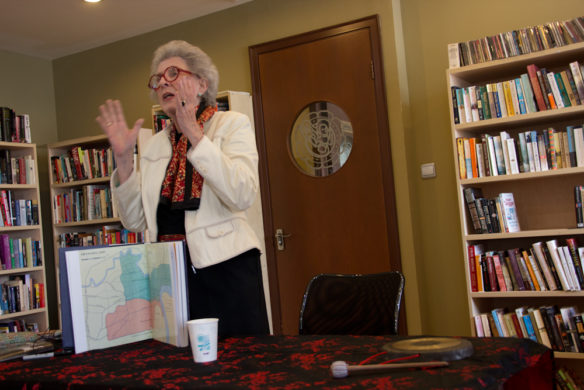
Tess Johnson gave a fascinating talk—“A Hundred Years in Fifty Minutes”—about Shanghai’s colorful history and the life of expatriates living in China.
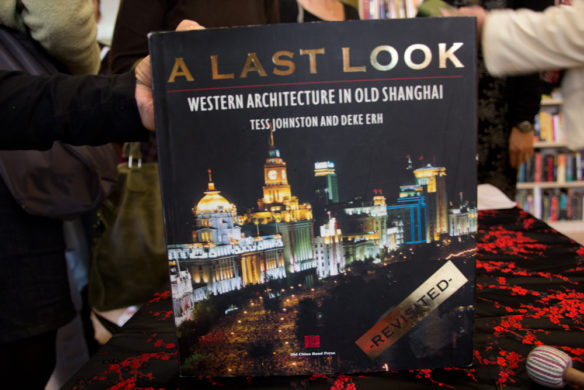
Tess has published and co-authored 25 books with Shanghai photographer Deke Erh, including A Last Look: Western Architecture in Old Shanghai and French Town Shanghai: Western Architecture in Shanghai’s Old French Concession.

The author with me, Jeanne Lawrence. Tess’s latest book, Permanently Temporary: From Berlin to Shanghai in Half a Century, is the story of her life through fourteen Foreign Service postings.
Photographs by Jeanne Lawrence.
*Urbanite Jeanne Lawrence reports on lifestyle and travel from her homes in San Francisco, Shanghai, and New York, and wherever else she finds a good story.
